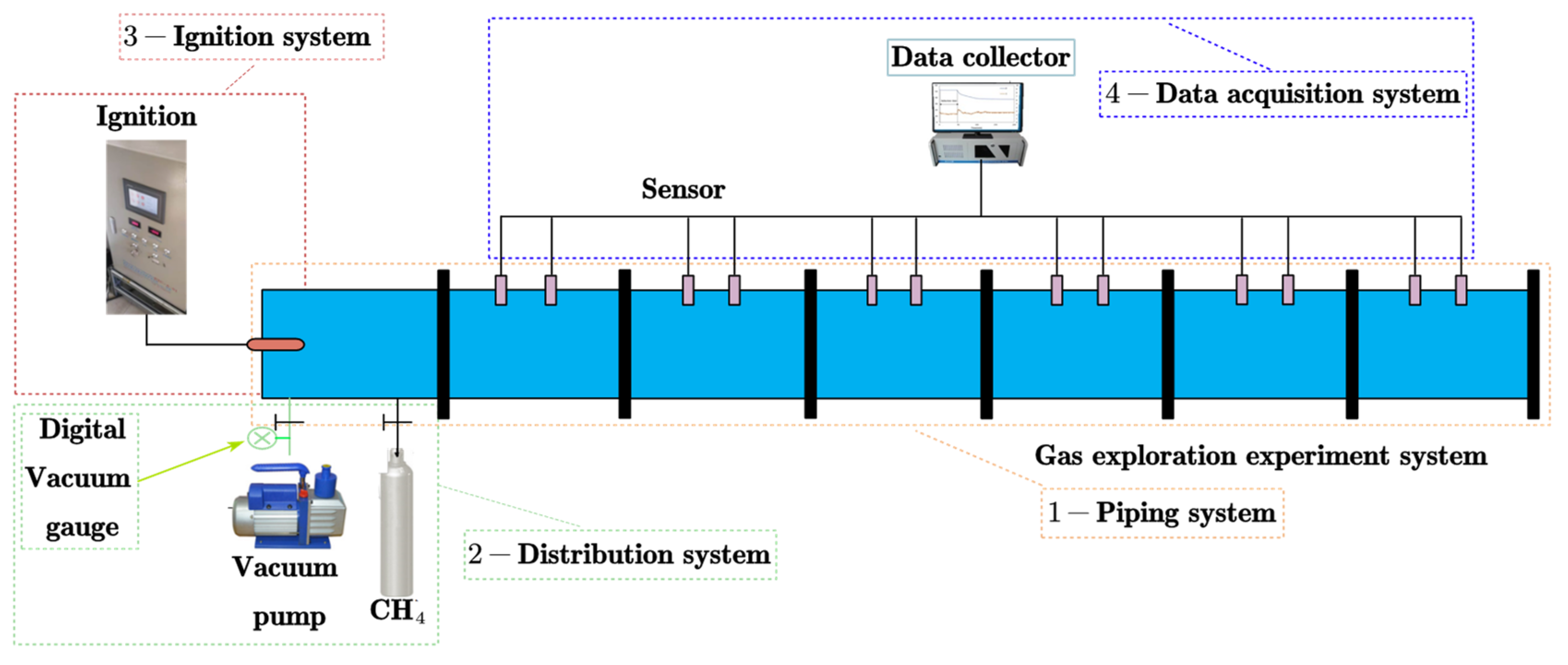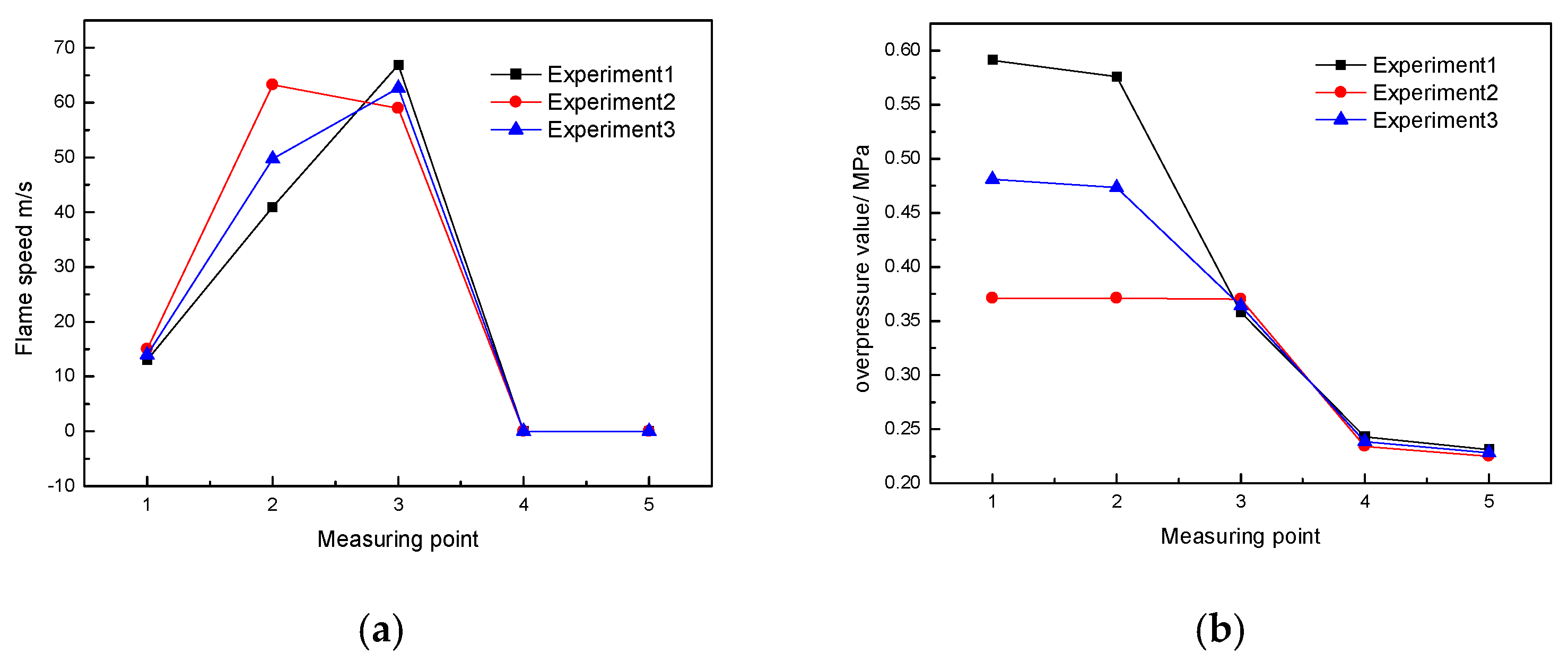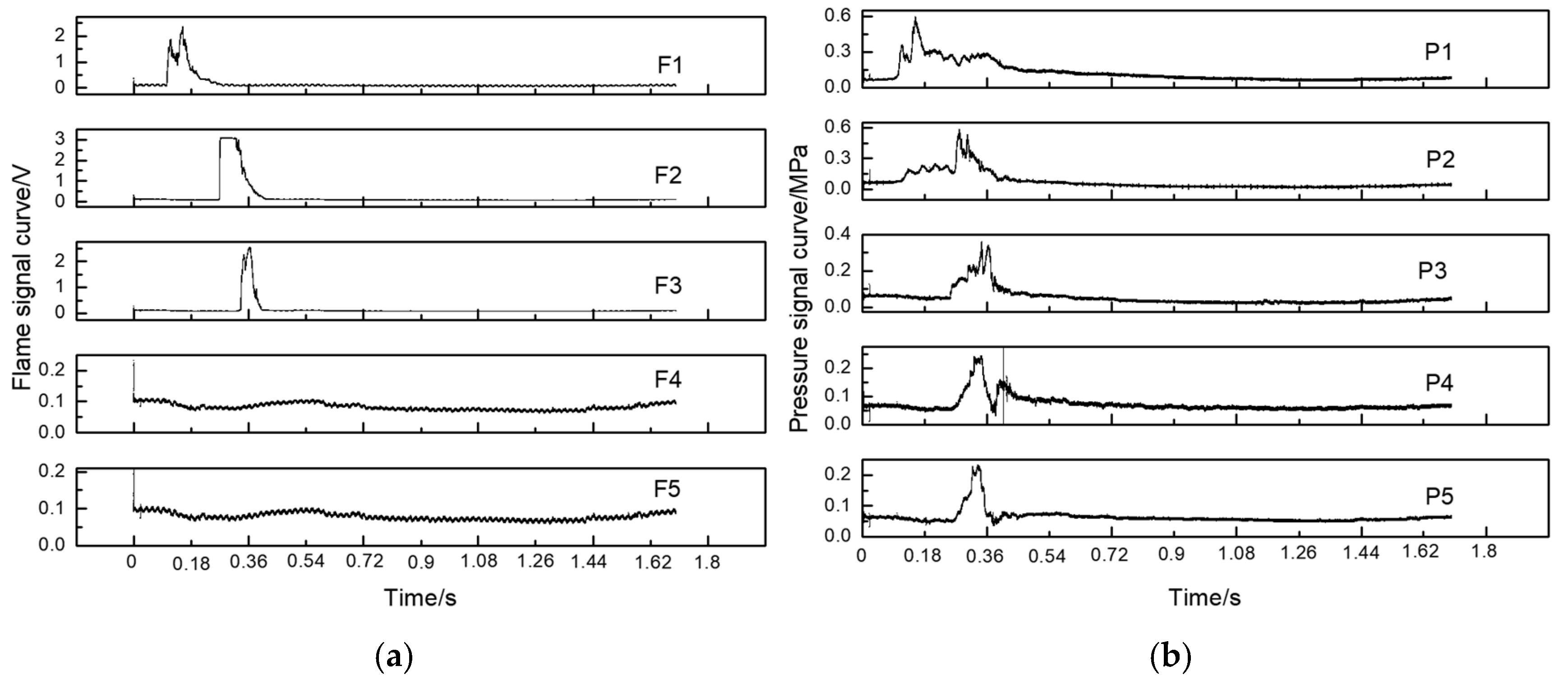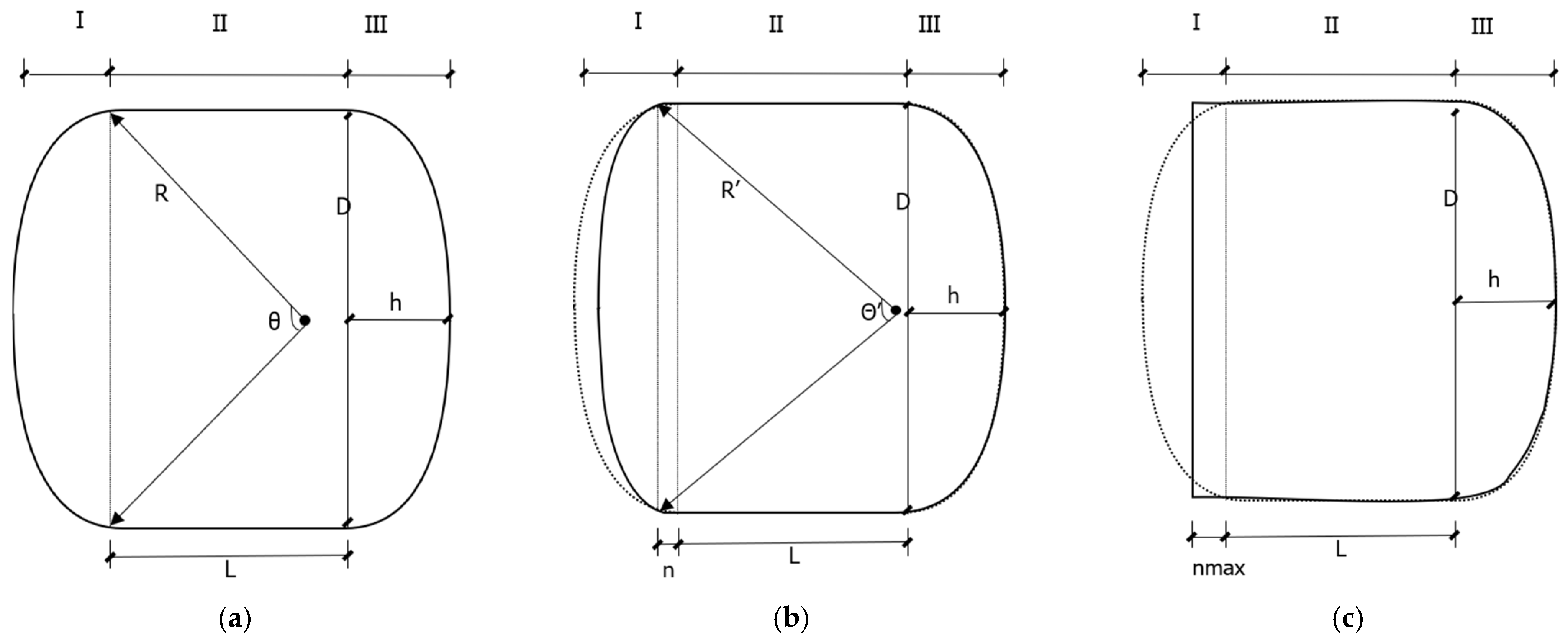Mechanism Analysis of Airbag Explosion Suppression and Energy Absorption in a Flexible Explosion Suppression System
Abstract
:1. Introduction
2. Experimental System and Method
2.1. Flexible-Airbag Gas-Explosion Suppression System
2.2. Gas Explosion Experiment System
2.3. Experimental Process


3. Results and Discussion
3.1. Deformation and Energy Absorption of the Airbag
3.2. Analysis of the Energy Absorption Effect
3.2.1. Two-Dimensional Model Assumptions
3.2.2. Airbag Initial State Analysis
3.2.3. Airbag Shape and Force Analysis after Being Subjected to a Shock Wave
3.2.4. Analysis of Airbag Deformation Limit State
3.2.5. Equilibrium Analysis of Airbag Horizontal Force
4. Conclusions
- (1)
- A flexible detonation suppression method based on the energy absorption principle is proposed for the first time, verifying the relevance of this method through several experiments. After the suppression airbag is started in the pipeline, at 1.5 m away from the front of the suppression airbag, the maximum overpressure at P3 monitoring point is 0.358–0.37 MPa, and the average flame velocity at F3 flame detection point is between 58.96 m/s and 66.90 m/s. The pressure and flame velocity decreased at least 34.86% and 73.10%, respectively, when compared with the empty pipe experiment. After the explosion suppression airbag actuation, the explosion flame propagation is completely inhibited.
- (2)
- Moreover, by comparing the occurrence time of maximum overpressure at different pressure monitoring points in the pipeline, P3 is generally later than P4, with a time difference between 1.47 ms and 39 ms, which verifies the shrinkage and deformation process of the airbag and reflects the existence of the energy absorption process of the airbag. In the process of energy absorption by the airbag, the flame is extinguished naturally, because the methane in the pipeline cannot be replenished, which leads to the interruption of the explosion.
- (3)
- Based on the two-dimensional model, the stress and deformation theory of the explosion suppression airbag is analyzed. The law of deformation energy absorption and the relationship between internal pressure and external pressure during the process of the airbag from the initial state to the ultimate state are obtained. In the limit state of airbag deformation, the theoretical pressure of P3 is 0.3423 MPa, and the difference between P3 and the maximum overpressure value measured in the experiment is 0.0148~0.0268 MPa, with an error of only 7.8%. There is a good consistency between the theoretical data and the experimental data.
Author Contributions
Funding
Institutional Review Board Statement
Informed Consent Statement
Data Availability Statement
Acknowledgments
Conflicts of Interest
References
- Chen, Z. Analysis on explosion of combustible gases in underground fire zone. Coal Mine Mod. 2005, 5, 17–18. [Google Scholar]
- Liu, Y.L.; Chen, H.B. Poison gases propagation rules of methane explosion in coal mine. J. China Coal Soc. 2009, 34, 788–791. [Google Scholar]
- Mohammed, J.A.; Jafar, Z.; Behdad, M. The flame deflagration of hybrid methane coal dusts in a large-scale detonation tube (LSDT). Fuel 2017, 194, 491–502. [Google Scholar]
- Mohammed, J.A.; Jafar, Z.; Behdad, M. Impact of suspended coal dusts on methane deflagration properties ina large-scale straight duct. J. Hazard. Mater. 2017, 338, 334–342. [Google Scholar]
- Mohammed, J.A.; Jafar, Z.; Behdad, M. Flame deflagration in side-on vented detonation tubes: A large scalestudy. J. Hazard. Mater. 2018, 345, 38–47. [Google Scholar]
- Mohammed, J.A.; Jafar, Z.; Behdad, M. Methane-coal dust hybrid fuel explosion properties in a largescale cylindrical explosion chamber. J. Loss Prev. Process Ind. 2016, 40, 317–328. [Google Scholar]
- Bai, C.; Gong, G.; Liu, Q.; Chen, Y.; Niu, G. The explosion overpressure field and flame propagation of methane/air and methane/coal dust/air mixtures. Saf. Sci. 2011, 49, 1349–1354. [Google Scholar] [CrossRef]
- Li, M.; Xu, J.; Wang, C.; Wang, B. Thermal and kinetics mechanism of explosion mitigation of methane-air mixture by N2/CO2 in a closed compartment. Fuel 2019, 255, 115747. [Google Scholar] [CrossRef]
- Lu, C.; Wang, H.; Pan, R.; Zhang, Y.; Yu, M. Preventing the propagation of gas explosion in ducts using spurted nitrogen. Process Saf. Environ. Prot. 2019, 123, 11–23. [Google Scholar] [CrossRef]
- Yang, H.-N.; Lin, Y.-J.; Liu, C.-H.; Chin, M.-G.; Wang, C.-C.; Tsai, H.-Y.; Chen, J.-R. Suppression of flame propagation in a long duct by inertia isolation with inert gases. J. Loss Prev. Process Ind. 2019, 59, 23–34. [Google Scholar] [CrossRef]
- Lisochkin, Y.; Poznyak, V.I. Inerting of Methane–Air Mixtures by Compositions Based on Carbon Dioxide and Nitrogen with Addition of Halocarbons. Combust. Explos. Shock Waves 2005, 41, 504–509. [Google Scholar] [CrossRef]
- Mitu, M.; Prodan, M.; Giurcan, V.; Razus, D.; Oancea, D. Influence of inert gas addition on propagation indices of methane–air deflagrations. Process Saf. Environ. Prot. 2016, 102, 513–522. [Google Scholar] [CrossRef]
- Song, Y.; Zhang, Q. The quantitative studies on gas explosion suppression by an inert rock dust deposit. J. Hazard. Mater. 2018, 353, 62–69. [Google Scholar] [CrossRef] [PubMed] [Green Version]
- Sun, Y.; Yuan, B.; Chen, X.; Li, K.; Wang, L.; Yun, Y.; Fan, A. Suppression of methane/air explosion by kaolinite-based multi-component inhibitor. Powder Technol. 2019, 343, 279–286. [Google Scholar] [CrossRef]
- Wang, Y.; Feng, H.; Zhang, Y.; Lin, C.; Zheng, L.; Ji, W.; Han, X. Suppression Effects of Hydroxy Acid Modified Montmorillonite Powders on Methane Explosions. Energies 2019, 12, 4068. [Google Scholar] [CrossRef] [Green Version]
- Liu, Q.; Hu, Y.; Bai, C.; Chen, M. Methane/coal dust/air explosions and their suppression by solid particle suppressing agents in a large-scale experimental tube. J. Loss Prev. Process Ind. 2013, 26, 310–316. [Google Scholar] [CrossRef]
- Chen, P.; Huang, F.; Sun, Y.; Chen, X. Effects of metal foam meshes on premixed methane-air flame propagation in the closed duct. J. Loss Prev. Process Ind. 2017, 47, 22–28. [Google Scholar] [CrossRef]
- Dai, H.; Wang, X.; Chen, X.; Nan, X.; Hu, Y.; He, S.; Yuan, B.; Zhao, Q.; Dong, Z.; Yang, P. Suppression characteristics of double-layer wire mesh on wheat dust flame. Powder Technol. 2020, 360, 231–240. [Google Scholar] [CrossRef]
- Wang, Y.; Meng, X.; Ji, W.; Pei, B.; Lin, C.; Feng, H.; Zheng, L. The Inhibitory effect of Gas–Solid Two-Phase Inhibitors on Methane Explosion. Energies 2019, 12, 398. [Google Scholar] [CrossRef] [Green Version]
- Yu, M.; Liu, M.; Wen, X.; Zhao, W.; Pei, B. Experimental study on suppression of methane explosion by porous media and ultra-fine water mist. Energy Sources Part A Recovery Util. Environ. Eff. 2019, 44, 1–14. [Google Scholar] [CrossRef]
- Polanczyk, A.; Wawrzyniak, P.; Zbicinski, I. CFD Analysis of Dust Explosion Relief Systemin the Counter-Current Industrial Spray Drying Tower. Dry. Technol. 2013, 31, 881–890. [Google Scholar] [CrossRef]
- Wawrzyniak, P.; Polańczyk, A.; Zbicinski, I.; Jaskulski, M.; Podyma, M.; Rabaeva, J. Modeling of Dust Explosion in the Industrial Spray Dryer. Dry. Technol. 2012, 30, 1720–1729. [Google Scholar] [CrossRef]
- Sohaimi, A.S.; Risby, M.S.; Ishak, S.A.; Khalis, S.; Norazman, M.N.; Ariffin, I.; Yusof, M.A. Using Computational Fluid Dynamics (CFD) for Blast Wave Propagation under Structure. Procedia Comput. Sci. 2016, 80, 1202–1211. [Google Scholar] [CrossRef] [Green Version]
- Díaz-Ovalle, C.; López-Molina, a.; Vázquez-Románc, R. A CFD-based approach to predict explosion overpressure: A comparison to current methods. Chem. Biochem. Eng. Q. 2016, 30, 419–427. [Google Scholar] [CrossRef]
- Eisenreich, N.; Neutz, J.; Seiler, F.; Hensel, D.; Stancl, M.; Tesitel, J.; Price, R.; Rushworth, S.; Markert, F.; Marcelles, I.; et al. Airbag for the closing of pipelines on explosions and leakages. J. Loss Prev. Process Ind. 2007, 20, 589–598. [Google Scholar] [CrossRef]
- Seiler, F.; Ende, H.; Hensel, D.; Srulijes, J. Experimental simulation of airbag deployment for pipeline closing. J. Loss Prev. Process Ind. 2005, 19, 292–297. [Google Scholar] [CrossRef]
- Eduardo, M.S.; Gregory, J.T.; Ever, J.B. Testing of Full-Scale Inflatable Plug for Flood Mitigation in Tunnels. Transp. Res. Rec. 2014, 59–67. [Google Scholar]
- Khan, M.U.; Moatamedi, M. A review of airbag test and analysis. Int. J. Crashworthiness 2008, 13, 67–76. [Google Scholar] [CrossRef]
- Jiang, L.; Zhang, Y.; Huang, Z.; Gao, Y.; Zhang, Y. International Symposium on Safety Science and Technology Experimental study of fast sealing airbag in simulating tunnel. Procedia Eng. 2012, 45, 780–785. [Google Scholar] [CrossRef] [Green Version]
- Eduardo, M.S.; Jerry, C.S.W.; Adi, A.; Ever, J.B.; Gregory, J.T. Finite element simulation of deployment of large-scale confined inflatable structures. Thin-Walled Struct. 2016, 104, 152–167. [Google Scholar]
- Wang, Y. Study on Gas Explosion Suppression Method under Flexible Constraint Conditions and Airbag Explosion Suppression System. China Univ. Min. Technol. 2019. [Google Scholar]
- Yan, S.; Chen, J.; Yue, C.; Sun, L.; Lang, R. Analytical and Model Test Study on the Behavior of Airbags Used for Plugging Tunnel Leakage. Chin. J. Undergr. Space Eng. 2019, 15, 736–746. [Google Scholar]
- Chen, J.; Yan, S.; Sun, L.; He, X.; Lang, R. Model test on deformation characteristics of large diameter airbag in tunnel under external pressure. J. Civ. Archit. Environ. Eng. 2018, 40, 16–26. [Google Scholar]
- Yan, S.; Chen, J.; Yue, C.; Sun, L.; Lang, R. Force Analysis Model and Experimental Verification of Rubber Airbag Used for Blocking Water in Tunnel. J. Tianjin Univ. (Sci. Technol.) 2018, 51, 221–231. [Google Scholar]
- Chen, J.; Yan, S.; Zhong, X. Finite element study on the working mechanism of sealing airbag in tunnel under external pressure. Mod. Tunn. Technol. 2021, 58, 135–144, 181. [Google Scholar]
- Chen, J.; Yan, S.; Sun, L. Working mechanism and model test of plugging airbags with different diameter matching under external pressure. J. Harbin Inst. Technol. 2018, 50, 130–137. [Google Scholar]
- Chen, J.; Yan, S.; Zhong, X. Deformation characteristics and failure mechanism of double-airbag system in tunnel under uniform external pressure. Ind. Constr. 2019, 49, 111–118. [Google Scholar]






| Pressure Sensor Number | Maximum Overpressure Occurrence Time (ms) | ||
|---|---|---|---|
| P1 | 170.48 | 158.03 | 156.04 |
| P2 | 312.19 | 264.68 | 274.01 |
| P3 | 383.36 | 310.106 | 392.40 |
| P4 | 381.89 | 171.83 | 290.36 |
| P5 | 371.02 | 272.22 | 263.58 |
Disclaimer/Publisher’s Note: The statements, opinions and data contained in all publications are solely those of the individual author(s) and contributor(s) and not of MDPI and/or the editor(s). MDPI and/or the editor(s) disclaim responsibility for any injury to people or property resulting from any ideas, methods, instructions or products referred to in the content. |
© 2023 by the authors. Licensee MDPI, Basel, Switzerland. This article is an open access article distributed under the terms and conditions of the Creative Commons Attribution (CC BY) license (https://creativecommons.org/licenses/by/4.0/).
Share and Cite
Wang, Y.; Ma, H.; Han, L.; Xu, X.; SKRZYPKOWSKI, K.; BASCOMPTA, M. Mechanism Analysis of Airbag Explosion Suppression and Energy Absorption in a Flexible Explosion Suppression System. Fire 2023, 6, 224. https://doi.org/10.3390/fire6060224
Wang Y, Ma H, Han L, Xu X, SKRZYPKOWSKI K, BASCOMPTA M. Mechanism Analysis of Airbag Explosion Suppression and Energy Absorption in a Flexible Explosion Suppression System. Fire. 2023; 6(6):224. https://doi.org/10.3390/fire6060224
Chicago/Turabian StyleWang, Yajun, Huihuan Ma, Li Han, Xiuyan Xu, Krzysztof SKRZYPKOWSKI, and Marc BASCOMPTA. 2023. "Mechanism Analysis of Airbag Explosion Suppression and Energy Absorption in a Flexible Explosion Suppression System" Fire 6, no. 6: 224. https://doi.org/10.3390/fire6060224
APA StyleWang, Y., Ma, H., Han, L., Xu, X., SKRZYPKOWSKI, K., & BASCOMPTA, M. (2023). Mechanism Analysis of Airbag Explosion Suppression and Energy Absorption in a Flexible Explosion Suppression System. Fire, 6(6), 224. https://doi.org/10.3390/fire6060224








